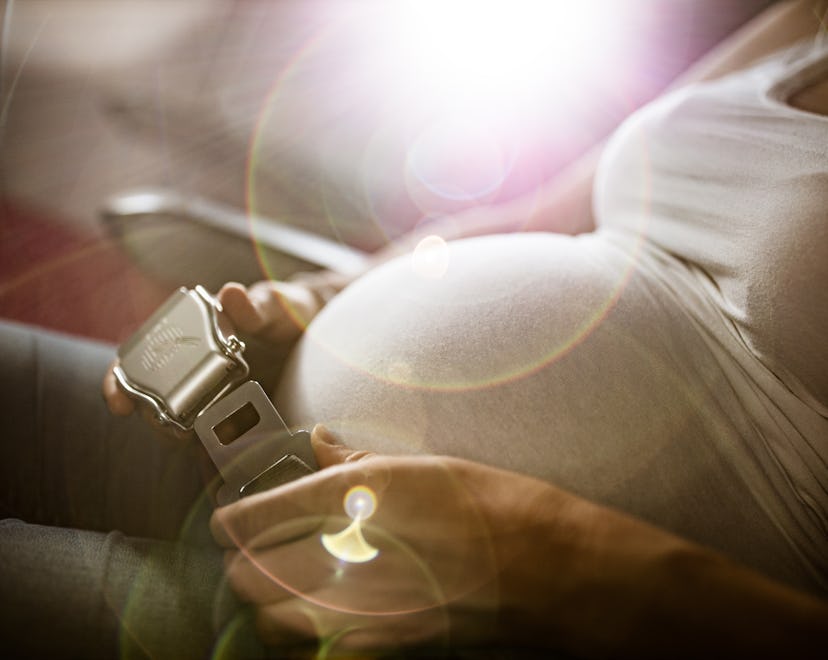Leaving On A Jet Plane

How To Fly Safely During Pregnancy
Because this might be the last time you can travel without stickers in your bag for a while.
If you’re expecting a new arrival and love to travel, you might wonder what the rules are for flying while pregnant. While flying with kids famously is anything but easy, flying with a baby who doesn’t yet cry and doesn’t yet need to be entertained or distracted from popping ears might seem like kind of a dream. When you’re pregnant, there’s no long travel checklist of things to pack — it’s maybe the most relaxed you’ll be on a flight for many years to come.
Whether you’re looking to do a “babymoon” with a partner or just see far-flung family or friends before this big change in your life, it might feel like 9 months is barely enough time to get in all the jet setting that you’re hoping for. But while flying while pregnant is definitely possible for most people through most of their pregnancy, there’s some basic safety information and a few time restrictions to keep in mind to ensure that travel goes smoothly for you and your soon-to-be little one. (Of course, talking to your own individual doctor or prenatal care team is always a good idea, too.)
Flying in early pregnancy
Unless your doctor has instructed you otherwise, flying in early pregnancy should be safe for most people. “In early pregnancy, the bony pelvis protects the uterus until it emerges into the abdomen at about 12 weeks,” Dr. Maureen Whelihan, an OB-GYN, explains. But when pregnant, you are at a higher risk of deep vein thrombosis — blood clots — which can travel to the lungs or brain and be extremely dangerous. To stave off your risk from DVT, Dr. Whelihan advises pregnant people to do ankle rolls and make sure you’re getting up to walk around the plane at least every two hours.
When to stop flying while pregnant
The general guideline is at 36 weeks, you should go back to staying on the ground. “Most commercial airlines allow pregnant people to fly until 36 weeks gestation, and most obstetric providers would concur with this advice,” Dr. Sonal Patel, a family medicine physician, explains. If you have risk factors for preterm labor or a history of preterm labor, however, you should discuss any flight plans with your obstetrics provider. “Flying may be contraindicated at any time during a pregnancy for folks who have a medical or obstetric complication,” Patel says. She also notes that flight crews or very frequent flyers may be at some risk for ionizing radiation, and should have a discussion with their provider about whether cutting back on the frequency of their flights is advised.
Tips to fly comfortably while pregnant
Airline seats can feel mighty snug even at the best of times, and pregnancy can involve pain even when you’re on the ground. That combination isn’t a winning one when it comes to figuring out how to stay comfortable while pregnant and flying. A few tips include:
- Wear compression socks. These not only can help ward off blood clots, but can keep your feet from swelling up, something that’s unfortunately common during pregnancy.
- Stay hydrated. Your body uses more water when you’re pregnant, and air travel is dehydrating to begin with. Those two facts taken together make it extra crucial that you keep your water bottle nearby.
- Bring a pillow. While a neck pillow might be part of your standard packing list, a small pillow that can go behind your back and relieve some of the pressure on your joints might help make the ride a little more comfortable.
- Request a bulkhead seat, or at least an aisle. While a first-class ticket is great if you can swing it, an exit row or bulkhead seat can give you a little extra room. This probably isn’t the flight to go for the super-saver middle seat, particularly given that you’ll need to be up and down to stretch your legs.
What to prepare when you fly during pregnancy
Even if you’re traveling before the 36-week mark, babies come on their own timetable, and don’t always get the memo that they’re not supposed to make their grand entrance quite yet. Being prepared for the possibility of a premature baby (which one in 10 babies is) will keep you from being blindsided. Whelihan suggests that pregnant people carry a card in their wallet with the following information: “estimated due date, blood type, OB doctor's contact info, allergies, and any medical conditions.” You also want to be prepared to receive care at your destination. “They should be aware of the availability of health resources at their destination like a maternity hospital especially when traveling to remote country cabins or other destinations,” Whelihan adds. It’s probably not a good idea to go too far off the grid once you’re approaching the 36-week mark — a relaxing pre-birth trip could turn into something else entirely if you go into labor while deep in the woods.
You shouldn’t fly when pregnant if...
- You’re 36 weeks or more
- You’re less than 36 weeks but have a high-risk condition and your doctor advises against it
- You have a history of risk factors for preterm labor — though this depends on how far along you are. Even if you have that history, you’ll likely be fine to travel in early pregnancy.
When you’re pregnant, there’s often no one-size-fits-all answer. The advice boils down to: talk to your doctor, and let them know of any trips you’re hoping to take. They will be able to assess your individual health and pregnancy status, and advise you on the best course of action so you can get some fun travel under your belt before your little one arrives.
Experts:
Maureen Whelihan, M.D., OB-GYN
This article was originally published on